LSTM TensorFlow Implementation: Complete Guide with Code & Best Practices
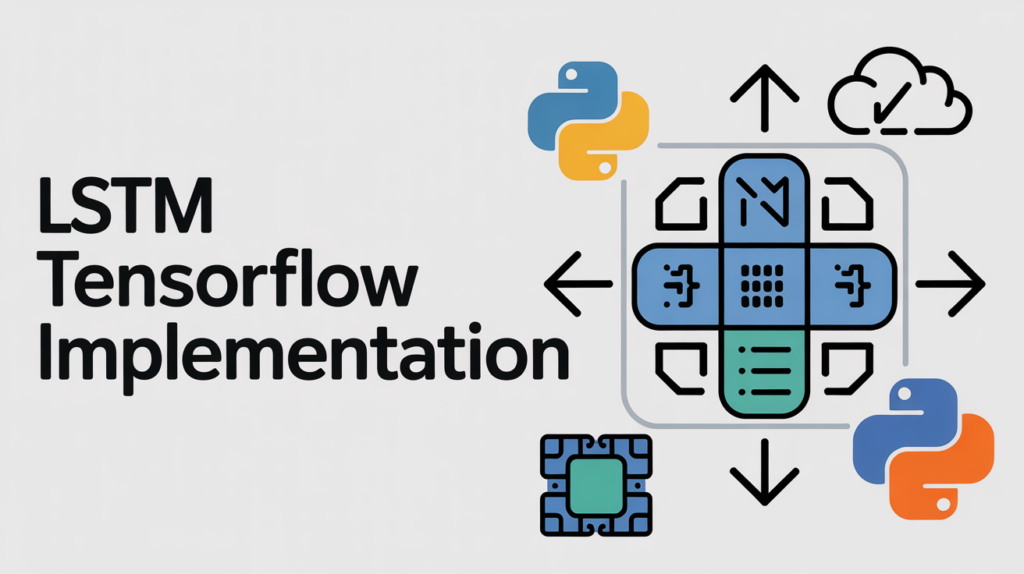
Whether you’re building stock predictors, text generators, or sequence models for time series forecasting, LSTM with TensorFlow is a must-have skill in your deep learning toolkit.
This guide will help you:
✅ Understand the LSTM basics in TensorFlow
✅ Choose between Keras Sequential and Functional API
✅ Implement a working example step-by-step
✅ Optimize performance with GPU and TensorBoard
✅ Avoid common pitfalls in real-world production setups
Let’s dive in!
🔍 Why Use TensorFlow for LSTM?
TensorFlow has become the industry standard for building scalable deep learning models. Combined with Keras, its high-level API, you can create robust LSTM architectures with just a few lines of Python.
✅ Key Advantages:
- Intuitive model building (Sequential & Functional APIs)
- Built-in support for GPUs & TPUs
- Eager execution mode for debugging
- Production-ready deployment options
🧩 Setting Up Your LSTM TensorFlow Project
Before you start coding, make sure you have:
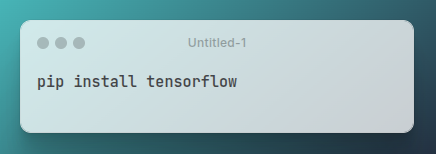
📚 Core LSTM TensorFlow Concepts
When you call tf.keras.layers.LSTM, TensorFlow handles the full sequence of operations:
- Gates: forget, input, output
- Cell state updates
- Hidden state propagation through time
- Automatic batching and masking
You can customize:
- Number of LSTM units (hidden size)
- Bidirectionality
- Return sequences or last output
- Stacking multiple LSTM layers
⚙️ Example: Simple LSTM Model in TensorFlow
Here’s a minimal yet clear example of using LSTM in TensorFlow:
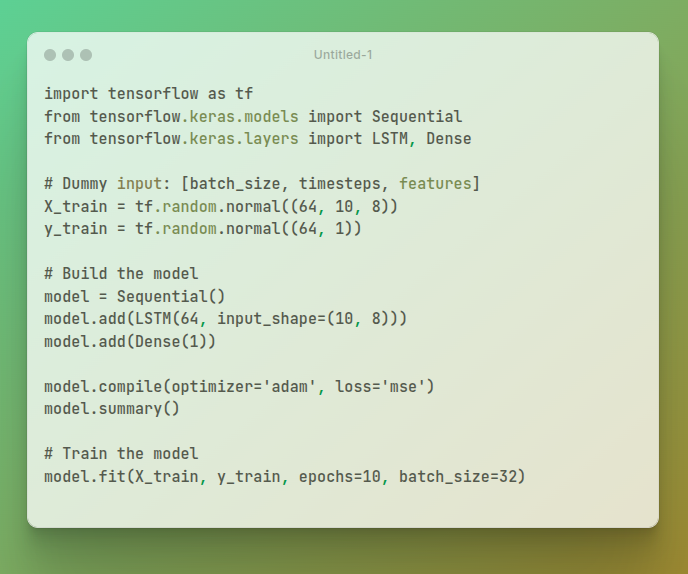
✅ Key points:
input_shape=(timesteps, features)return_sequences=Falseby default (last output only)
🔄 Stacking LSTM Layers
Want more power? Stack LSTM layers!
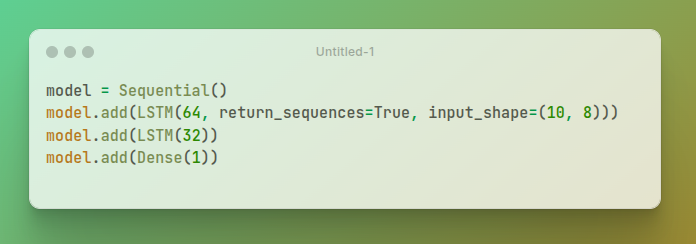
✅ return_sequences=True must be set for all intermediate LSTM layers.
🔬 Using the Functional API for More Flexibility
When you need multiple inputs/outputs or custom flows:
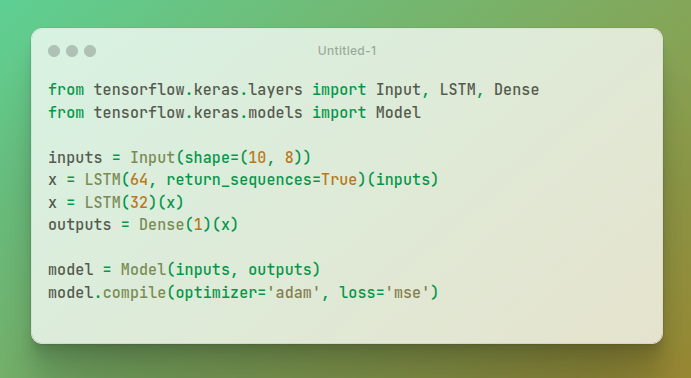
✅ Tip: The Functional API is best for complex architectures.
🚀 Best Practices for LSTM in TensorFlow
✅ Use GPU Acceleration:
LSTM operations are computationally intensive. Always use a GPU if available.

✅ Gradient Clipping:
Prevent exploding gradients by adding clipnorm or clipvalue to your optimizer.
✅ Regularization:
Apply Dropout or RecurrentDropout to LSTM layers to reduce overfitting.
✅ Monitoring with TensorBoard:
Use callbacks to log training for performance insights:
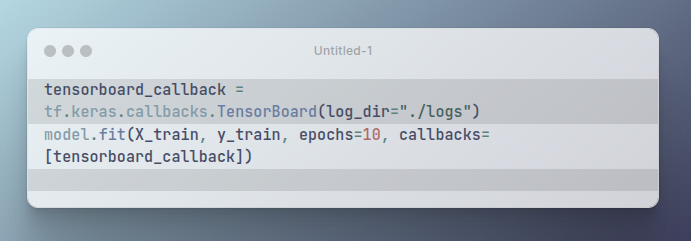
✅ Save & Reload:
Serialize your model for production:
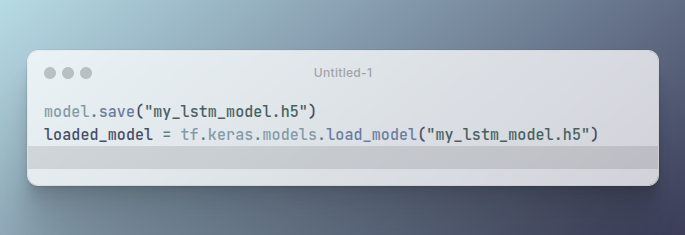
🔍 Common Pitfalls with LSTM in TensorFlow
❌ Feeding variable-length sequences without padding/masking.
✅ Use Masking or pad_sequences.
❌ Mismatched input shapes.
✅ Always confirm your (timesteps, features) dimensions.
❌ Ignoring bidirectional or stacked variants when your data would benefit.
📈 LSTM TensorFlow for Real-World Applications
Stock Prediction: Learn patterns over time and predict future trends.
Text Generation: From simple character-level RNNs to powerful sequence-to-sequence LSTM models.
Speech Recognition & Audio: Combine LSTM layers with CNNs or Attention for better feature extraction.
✅ Tip: Experiment with Bidirectional wrappers and Attention layers for advanced NLP.
📚 Check Out Our Other Python Installation Guides
If you’re setting up your environment for TensorFlow, you might also find these helpful:
- ✅ Python version management for TensorFlow compatibility
- ✅ Virtual environments for clean installs
- ✅ GPU drivers and CUDA setup for TensorFlow
- ✅ Installing Jupyter Notebooks for experiments
👉 Explore these to build a rock-solid foundation for your LSTM projects!
🌐 Useful Links
- TensorFlow Official Guide: Recurrent Layers
- TensorFlow Tutorials: Text Generation with LSTM
❓ FAQs About LSTM TensorFlow
1. What’s the difference between TensorFlow and Keras LSTM?tf.keras is the high-level API inside TensorFlow — so you get the best of both worlds!
2. How do I debug shape mismatches?
Use model.summary() and print input shapes at each layer.
3. Can I use CuDNN for faster training?
Yes! TensorFlow’s LSTM automatically uses CuDNN kernels when available.
4. Should I use the Sequential or Functional API?
Use Sequential for simple stacks; use Functional for more advanced, branched models.
5. How do I deploy an LSTM TensorFlow model?
Save the model as .h5 or TensorFlow SavedModel format. Deploy via TensorFlow Serving, TFLite, or TF.js for the web.
📚 Check Out Our Other Python Installation Guides
If you’re working with Python, don’t miss our other detailed tutorials to help you get your environment set up smoothly:
- ✅ Installing Different Python Versions: Learn step-by-step how to manage multiple Python versions on your system.
Links:
📌 Python 3.13 installation guide (latest)
📌 Python 3.10 installation easy and beginner guide
Discover more from Neural Brain Works - The Tech blog
Subscribe to get the latest posts sent to your email.
